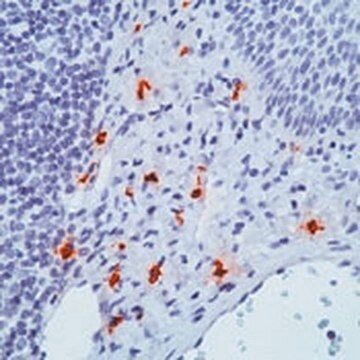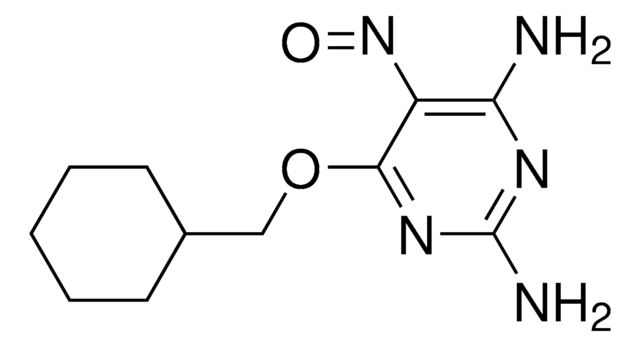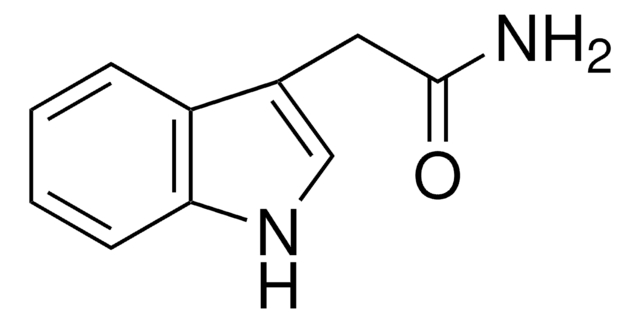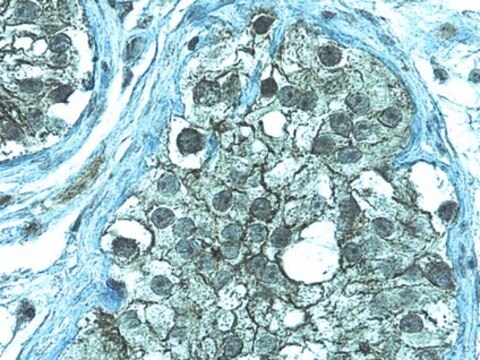MAB1222
Anti-Tryptase Antibody, Mast Cell, clone G3
clone G3, Chemicon®, from mouse
Synonym(s):
Mast cell tryptase antibody
Sign Into View Organizational & Contract Pricing
All Photos(2)
About This Item
UNSPSC Code:
12352203
eCl@ss:
32160702
NACRES:
NA.41
Recommended Products
biological source
mouse
Quality Level
antibody form
purified immunoglobulin
clone
G3, monoclonal
species reactivity
human
manufacturer/tradename
Chemicon®
technique(s)
flow cytometry: suitable
immunohistochemistry: suitable
western blot: suitable
isotype
IgG1κ
NCBI accession no.
UniProt accession no.
shipped in
wet ice
target post-translational modification
unmodified
General description
Tryptase is the most abundant secretory granule-derived serine proteinase contained in mast cells. Tryptase has recently been used as a marker for mast cell activation and is involved with allergic response. Tryptase may act as a mitogen for fibroblast lines. Elevated levels of serum tryptase occur in both anaphylactic and anaphylactoid reactions, but a negative test does not exclude anaphylaxis.
Specificity
Recognizes Mast cell tryptase. Will show reactivity to basophils but to a lesser degree.
Application
Flow Cytometry Analysis: A previous lot of this antibody has been used on fixed cells in FACS using a conjugated secondary antibody. (Sperr, W., et al., 2001).
Optimal working dilutions must be determined by end user.
Optimal working dilutions must be determined by end user.
Research Category
Inflammation & Immunology
Inflammation & Immunology
Research Sub Category
Inflammation & Autoimmune Mechanisms
Inflammation & Autoimmune Mechanisms
This Anti-Tryptase Antibody, Mast Cell, clone G3 is validated for use in FC, IH, WB for the detection of Tryptase.
Quality
Evaluated by western blot on human fetal skin lysate.
Western Blot Analysis: 0.5 µg/mL of this antibody detected tryptase in 10 µg of human fetal skin lysate.
Western Blot Analysis: 0.5 µg/mL of this antibody detected tryptase in 10 µg of human fetal skin lysate.
Target description
31 kDa
Physical form
Format: Purified
Protein G Purified
Purified mouse monoclonal IgG1κ in buffer containing 0.1 M Tris-Glycine (pH 7.4, 150 mM NaCl) with 0.05% sodium azide.
(see product datasheet for specific buffer formulation)
(see product datasheet for specific buffer formulation)
Storage and Stability
Maintain at 2–8°C for the duration listed on the product datasheet. (See product datasheet for storage conditions)
Analysis Note
Control
Mast cells, basophils
Human fetal skin lysate
Mast cells, basophils
Human fetal skin lysate
Other Notes
Concentration: Please refer to the Certificate of Analysis for the lot-specific concentration.
Legal Information
CHEMICON is a registered trademark of Merck KGaA, Darmstadt, Germany
Disclaimer
Unless otherwise stated in our catalog or other company documentation accompanying the product(s), our products are intended for research use only and are not to be used for any other purpose, which includes but is not limited to, unauthorized commercial uses, in vitro diagnostic uses, ex vivo or in vivo therapeutic uses or any type of consumption or application to humans or animals.
Storage Class Code
12 - Non Combustible Liquids
WGK
WGK 1
Flash Point(F)
Not applicable
Flash Point(C)
Not applicable
Certificates of Analysis (COA)
Search for Certificates of Analysis (COA) by entering the products Lot/Batch Number. Lot and Batch Numbers can be found on a product’s label following the words ‘Lot’ or ‘Batch’.
Already Own This Product?
Find documentation for the products that you have recently purchased in the Document Library.
A human lung tumor microenvironment interactome identifies clinically relevant cell-type cross-talk.
Andrew J Gentles et al.
Genome biology, 21(1), 107-107 (2020-05-10)
Tumors comprise a complex microenvironment of interacting malignant and stromal cell types. Much of our understanding of the tumor microenvironment comes from in vitro studies isolating the interactions between malignant cells and a single stromal cell type, often along a
T Kinoshita et al.
Blood, 94(2), 496-508 (1999-07-09)
In the present study, we attempted to clarify the effects of interleukin-6 (IL-6) on the growth and properties of human mast cells using cultured mast cells selectively generated by stem cell factor (SCF) from CD34(+) cord blood cells. The addition
Regulation of matrix metalloproteinases in human endometrium.
L A Salamonsen, J Zhang, A Hampton, L Lathbury, L A Salamonsen, J Zhang, A Hampton, L Lathbury
Human Reproduction null
Christian Breuer et al.
World journal of gastroenterology, 16(34), 4363-4366 (2010-09-08)
Constipation and fecal impaction are frequent and distressing complaints in pediatric gastroenterology. Especially in neurologically handicapped children, treatment of severe forms of slow-transit constipation (STC) can be difficult. In the majority of cases, STC is of unknown etiology. However, in
Serum inhibitors for human mast cell growth: possible role of retinol.
S Ishida, T Kinoshita, N Sugawara, T Yamashita, K Koike
Allergy null
Our team of scientists has experience in all areas of research including Life Science, Material Science, Chemical Synthesis, Chromatography, Analytical and many others.
Contact Technical Service








